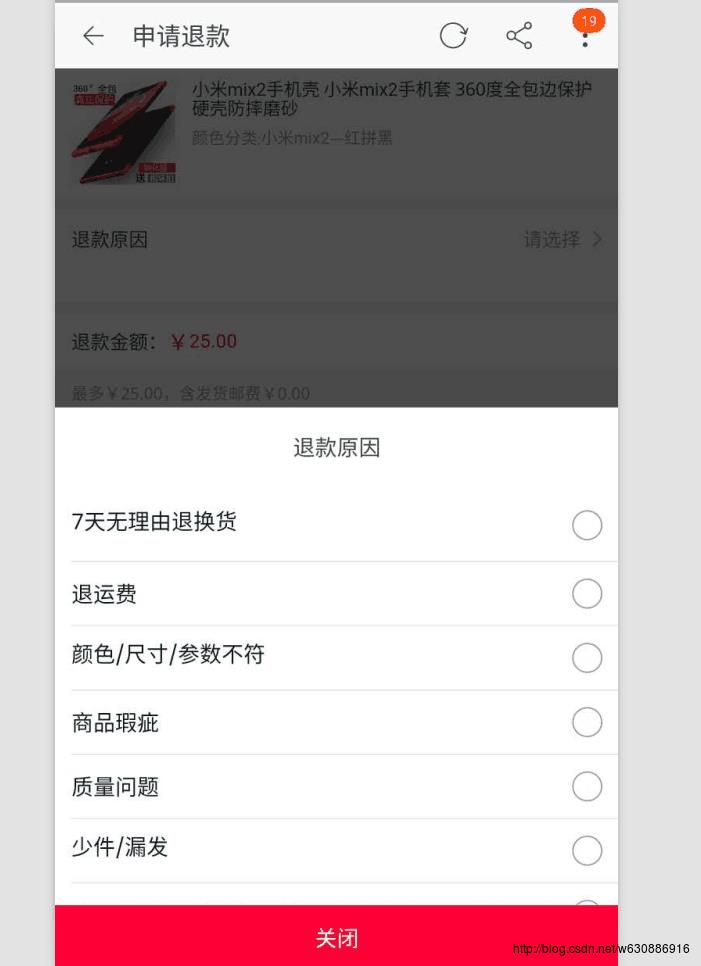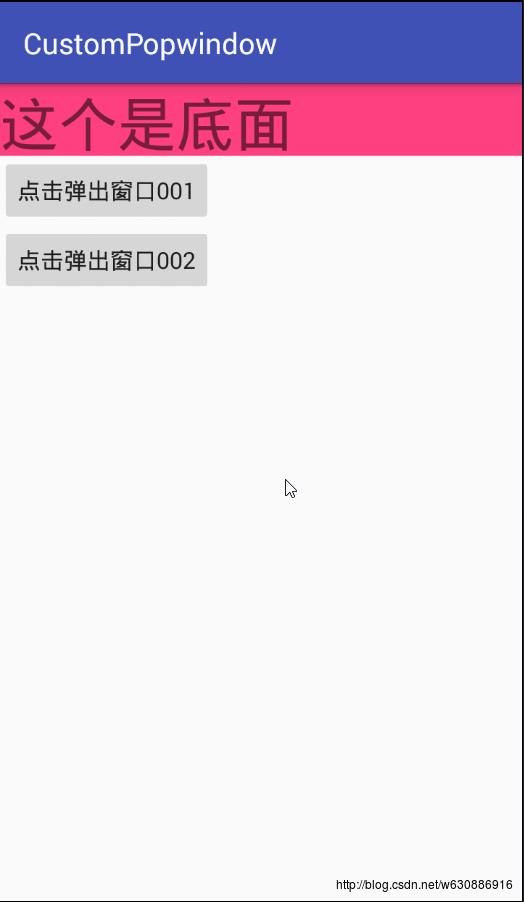Android Popwindow使用总结
Posted
tags:
篇首语:本文由小常识网(cha138.com)小编为大家整理,主要介绍了Android Popwindow使用总结相关的知识,希望对你有一定的参考价值。
参考技术A 1.基本属性方法2.在弹窗出现后让背景变暗,并在弹窗消失后让背景还原
3.添加动画
自定义一个动画
添加动画
只有同时设置PopupWindow的背景和可以响应外部点击事件,它才能“真正”响应外部点击事件。也就是说,当你点击PopupWindow的外部或者按下“Back”键时,PopupWindow才会消失。
1.在popwindow中嵌套viewpager时候,关于定位问题:首先保证viewpager类是同一个,就是没有新new一个类。然后在show的时候记得setCurrentItem()一下就好了。
android PopupWindow使用方法小结
Android中文API——PopupWindow
喵印~~
Android自定义半透明背景弹窗非popwindow/dialog超简单任意编写!
前日,一个朋友问我有没有好看的弹窗,功能不需要太难,说了一点需求,图:

然后我就写了个Demo给他。
Activity的弹窗各种各样。很早就有,但是有的太过于单调,样式也不好看,有的自定义起来非常繁琐。
我结合自定义Activity主题style,写了个很简单的Fragment组合应用。
前提说明:
——开发工具:Android studio64位 3.0 版本
——声明控件使用butterknife
(build.gradle文件里dependencies内直接加入compile ‘com.jakewharton:butterknife:8.6.0’)
——模拟器版本:逍遥模拟器Android 4.3
——Demo中有些地方引用了自定义的color和style(路径:src-mian-res-values)
——AndroidManifest.xml 里对应的CustomPopwindowActivity类(弹窗类)自定义了主题
<activity
android:name=".CustomPopwindowActivity"
android:theme="@style/bottom_dialog"></activity>这里注意一下:
布局文件为了显示效果写了很多无用的控件,主要是为了体现效果,主要关键地方,我会单独描述出来
三段式介绍:主要内容摘要介绍,主要代码块粘贴,文末有Demo下载
先上个比较粗糙的效果图:

然后上干货:
主要代码块:
主页面:
/**
* 自定义弹窗
* 声明控件用的是butterknife,添加方法:
* app的build.gradle里面
* dependencies 括号里添加
* annotationProcessor 'com.jakewharton:butterknife-compiler:8.6.0'
* compile 'com.jakewharton:butterknife:8.6.0'
* 用什么声明随意,根据自己要求就行
*/
public class MainActivity extends AppCompatActivity
@BindView(R.id.button)
Button button;
@BindView(R.id.button2)
Button button2;
@Override
protected void onCreate(Bundle savedInstanceState)
super.onCreate(savedInstanceState);
setContentView(R.layout.activity_main);
ButterKnife.bind(this);
//两个按钮的点击事件
@OnClick(R.id.button, R.id.button2)
public void onClick(View view)
switch (view.getId())
case R.id.button:
Bundle bundle = new Bundle();
bundle.putInt("key", 1);
Intent intent = new Intent(MainActivity.this, CustomPopwindowActivity.class);
intent.putExtras(bundle);
startActivity(intent);
break;
case R.id.button2:
Bundle bundle2 = new Bundle();
bundle2.putInt("key", 2);
Intent intent2 = new Intent(MainActivity.this, CustomPopwindowActivity.class);
intent2.putExtras(bundle2);
startActivity(intent2);
break;
主页面 布局:
<LinearLayout xmlns:android="http://schemas.android.com/apk/res/android"
xmlns:tools="http://schemas.android.com/tools"
android:layout_width="match_parent"
android:layout_height="match_parent"
android:orientation="vertical"
tools:context="com.individual.wzq.custompopwindow.MainActivity">
<TextView
android:layout_width="match_parent"
android:layout_height="50dp"
android:background="@color/colorAccent"
android:text="这个是底面"
android:textSize="35sp" />
<Button
android:id="@+id/button"
android:layout_width="wrap_content"
android:layout_height="wrap_content"
android:text="点击弹出窗口001" />
<Button
android:id="@+id/button2"
android:layout_width="wrap_content"
android:layout_height="wrap_content"
android:text="点击弹出窗口002" />
</LinearLayout>第二个Activity页面:
/**
* 显示的弹窗主页面
* 在AndroidManifest.xml里,
* CustomPopwindowActivity的添加自定义主题样式,自定义一些style属性(在src-main-res-values-style里)
*/
public class CustomPopwindowActivity extends AppCompatActivity
@BindView(R.id.body)
LinearLayout body;
private int type;
//创建一个基类Fragment
BaseFragment baseFragment;
@Override
protected void onCreate(Bundle savedInstanceState)
super.onCreate(savedInstanceState);
setContentView(R.layout.activity_custom_popwindow);
ButterKnife.bind(this);
//加载数据
getData();
//计算弹窗显示的大小
Window dialogWindow = getWindow();
WindowManager.LayoutParams lp = dialogWindow.getAttributes(); // 获取对话框当前的参数值
lp.width = WindowManager.LayoutParams.MATCH_PARENT;
lp.height = WindowManager.LayoutParams.MATCH_PARENT;
dialogWindow.setAttributes(lp);
//添加Fragment
addFragment();
private void getData()
Bundle bundle = getIntent().getExtras();
if (bundle != null)
type = bundle.getInt("key", 1);//默认为1 按需求可以任意写值(可以不写,系统默认为0)
private void addFragment()
//通过动态配置参数,替换Fragment显示
switch (type)
case 1:
baseFragment = new NewFragment();
break;
case 2:
baseFragment = new NewFragment2();
break;
getSupportFragmentManager().beginTransaction().replace(R.id.body, baseFragment).commit();
第二个Activity 布局文件:
<?xml version="1.0" encoding="utf-8"?>
<RelativeLayout xmlns:android="http://schemas.android.com/apk/res/android"
android:layout_width="match_parent"
android:layout_height="match_parent"
android:background="@color/half10_transparent"
android:focusable="true"
android:focusableInTouchMode="true">
<ScrollView
android:layout_width="match_parent"
android:layout_height="wrap_content"
android:layout_alignParentBottom="true">
<LinearLayout
android:id="@+id/body"
android:layout_width="match_parent"
android:layout_height="wrap_content"
android:orientation="vertical"
android:transitionName="EditModel"></LinearLayout>
</ScrollView>
</RelativeLayout>内嵌的Fragment第一个:
/**
* 继承父类BaseFragment(用于写一些公共的方法和资源)
* 根据自己需求,编写本页面需要的样式和功能
*/
public class NewFragment extends BaseFragment
@BindView(R.id.radioButton1)
RadioButton radioButton1;
@BindView(R.id.radioButton2)
RadioButton radioButton2;
@BindView(R.id.radioButton3)
RadioButton radioButton3;
@BindView(R.id.radioButton4)
RadioButton radioButton4;
@BindView(R.id.button2)
Button button2;
@BindView(R.id.bottomView)
LinearLayout bottomView;
@Nullable
@Override
public View onCreateView(LayoutInflater inflater, @Nullable ViewGroup container, @Nullable Bundle savedInstanceState)
View view = inflater.inflate(R.layout.add_new_expect_layout, null);
ButterKnife.bind(this, view);
button2.setOnClickListener(new View.OnClickListener()
@Override
public void onClick(View view)
getActivity().finish();
);
return view;
@Override
public void onDestroyView()
super.onDestroyView();
第一个Fragment布局文件:
<?xml version="1.0" encoding="utf-8"?>
<LinearLayout xmlns:android="http://schemas.android.com/apk/res/android"
android:id="@+id/bottomView"
android:layout_width="match_parent"
android:layout_height="wrap_content"
android:background="@color/white"
android:orientation="vertical">
<TextView
android:layout_width="match_parent"
android:layout_height="wrap_content"
android:gravity="center"
android:text="退款原因" />
<RadioGroup
android:layout_width="match_parent"
android:layout_height="wrap_content">
<RadioButton
android:id="@+id/radioButton1"
android:layout_width="match_parent"
android:layout_height="wrap_content"
android:text="RadioButton" />
<RadioButton
android:id="@+id/radioButton2"
android:layout_width="match_parent"
android:layout_height="wrap_content"
android:text="RadioButton" />
<RadioButton
android:id="@+id/radioButton3"
android:layout_width="match_parent"
android:layout_height="wrap_content"
android:text="RadioButton" />
<RadioButton
android:id="@+id/radioButton4"
android:layout_width="match_parent"
android:layout_height="wrap_content"
android:text="RadioButton" />
</RadioGroup>
<Button
android:id="@+id/button2"
android:layout_width="match_parent"
android:layout_height="wrap_content"
android:background="@color/colorAccent"
android:text="关 闭"
android:textSize="25sp" />
</LinearLayout>内嵌的Fragment第二个:
/**
* 继承父类BaseFragment(用于写一些公共的方法和资源)
* 根据自己需求,编写本页面需要的样式和功能
*/
public class NewFragment2 extends BaseFragment
@BindView(R.id.button2)
Button button2;
@BindView(R.id.bottomView)
LinearLayout bottomView;
@Nullable
@Override
public View onCreateView(LayoutInflater inflater, @Nullable ViewGroup container, @Nullable Bundle savedInstanceState)
View view = inflater.inflate(R.layout.add_new_expect_layout2, null);
ButterKnife.bind(this, view);
button2.setOnClickListener(new View.OnClickListener()
@Override
public void onClick(View view)
getActivity().finish();
);
return view;
@Override
public void onDestroyView()
super.onDestroyView();
第二个Fragment布局文件:
<?xml version="1.0" encoding="utf-8"?>
<LinearLayout xmlns:android="http://schemas.android.com/apk/res/android"
android:id="@+id/bottomView"
android:layout_width="match_parent"
android:layout_height="wrap_content"
android:background="@color/white"
android:orientation="vertical">
<TextView
android:layout_width="match_parent"
android:layout_height="wrap_content"
android:background="@color/colorPrimaryDark"
android:gravity="center"
android:text="另一个窗口"
android:textSize="30sp" />
<EditText
android:layout_width="match_parent"
android:layout_height="wrap_content"
android:hint="这里可以的输入内容" />
<Button
android:layout_width="match_parent"
android:layout_height="wrap_content"
android:text="Button" />
<Button
android:layout_width="match_parent"
android:layout_height="wrap_content"
android:text="Button" />
<Button
android:layout_width="match_parent"
android:layout_height="wrap_content"
android:text="Button" />
<Button
android:layout_width="match_parent"
android:layout_height="wrap_content"
android:text="Button" />
<Button
android:id="@+id/button2"
android:layout_width="match_parent"
android:layout_height="wrap_content"
android:background="@color/colorAccent"
android:text="关 闭"
android:textSize="25sp" />
</LinearLayout>Demo下载:http://download.csdn.net/download/w630886916/10050624
以上是关于Android Popwindow使用总结的主要内容,如果未能解决你的问题,请参考以下文章